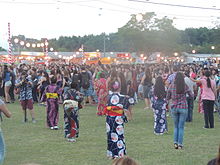Bon Odori
The Bon Odori (盆踊り, Bon Odori?) is a traditional Japanese dance festival. Bon Odori is celebrated in Japan every summer (between July and August) and is organized locally by each city.
Bon is a festive season during which the souls of the ancestors are welcomed. The Bon is a Buddhist tradition, originating in China.
During Bon Odori, people gather in open spaces around a tower with taiko drums (Japanese drums) and dance to traditional music. The music should be joyful to welcome the souls of the ancestors and the people should maintain a cheerful mood. Bon Odori must be celebrated at night because it is believed that the souls of the ancestors return during the night.
Main Obon rituals
On the first day, families clean their family graves and call the ancestral spirits back home. The lanterns are lit on the night of August 13 in the ritual at the doors of the houses and inside them in a “mukae-bon” ritual, to welcome the souls of loved ones. A cucumber is decorated with four sticks, to symbolize a horse, so that the spirits can arrive faster. On the 16th, the eggplant represents the ox so that the ancestors return more slowly to their world. The Bon Odori folk dance is performed in the streets throughout the festival, as well as in temples, parks and gardens, to the sound of Taiko drums, with dancers wearing yukata (summer kimono). And anyone can join the dance. On the last day of the festival, the Japanese use their creativity to make paper lanterns, painted with the name or family crest. In a ritual called Tooro Nagashi, lanterns are placed in rivers, lakes, and seas to show the family spirits the way back to their world.
Argentina
In Argentina, the Japanese community celebrates it during the southern summer.
Since 1999, in Colonia Urquiza, La Plata district, the "Bon Odori La Plata" on the premises of the Japanese School of said city (186 and 482 streets). Every year, on the second Saturday of January (according to the Spanish calendar), thousands of people join the celebration. Throughout the afternoon and evening there are taiko and daiko shows, traditional dance presentations, a crafts and clothing fair, games, a food court, fireworks displays and the traditional collective dance around the main tower (yagura)
Contenido relacionado
Jota (music)
Boa
National Anthem of El Salvador
Journalistic criticism
Mari (goddess)

